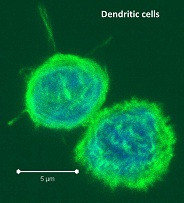When peripheral whole blood is drawn for human immune system studies, it is often processed to remove red blood cells by density gradient centrifugation. Most commonly this method uses Ficoll Paque, a solution of high molecular weight sucrose polymers, a product of GE Healthcare Ltd. Ficoll separates whole blood into two fractions above and below the density of 1.077g/ml.
Peripheral blood mononuclear cells (PBMC) are the populations of immune cells that remain at the less dense, upper interface of the Ficoll layer, often referred to as the buffy coat and are the cells collected when the Ficoll fractionation method is used.
Erythrocytes (red blood cells) and polymorphonuclear cells (PMNs) which include neutrophils and eosinophils are generally removed during this fractionation as they are denser then 1.077g/ml. Basophils, however can be greater or less dense then 1.077g/ml and thus may be present to a small degree in the less dense PBMC fraction.
PBMCs include lymphocytes (T cells, B cells, and NK cells), monocytes, and dendritic cells. In humans, the frequencies of these populations vary across individuals. In my experience as well as that of others, lymphocytes are typically in the range of 70 – 90% of PBMCs, monocytes range from 10 – 30% of PBMCs, while dendritic cells are rare, being only 1 – 2% of PBMCs. The frequencies of cell types within the lymphocyte population include 70 – 85% CD3+ T cells (45 – 70% of PBMC), 5 – 20% B cells (up to 15% of PBMC), and 5 – 20% NK cells (up to 15% of PBMC).
The CD3+ compartment is composed of CD4 (25 – 60% of PBMC) and CD8 T cells (5 – 30% of PBMC), in a roughly 2:1 ratio. Both CD4 and CD8 T cells can be further subsetted into naïve, and the antigen-experienced central memory, effector memory, and effector subtypes that exist in resting or activated states. Multiple markers can be used to identify these compartments to varying similarities and thus the frequencies reported by people using different markers may vary.
CD4 T cells are known as helper T cells and can be further classified into various functional subtypes based on the expression profiles of specific cytokines, surface markers, or transcription factors. These include regulatory T cells, TH1, TH2, and TH17 cells as well as other described subpopulations such as TH9, follicular helper, and TR1 types. These classifications however will certainly become more complex in the future, as recently the cytotoxic CD8 T cell compartment has been to shown to be extremely heterogenous in marker expression and function and may be comprised of roughly 200 functional phenotypes.
Circulating B cells include transitional, naïve, and memory subtypes as well as plasmablasts, all of which can be found at varying populations in peripheral blood. Circulating dendritic cells include plasmacytoid dendritic cells as well as myeloid derived dendritic cells. Circulating monocytes have been described as either being classical monocytes or nonclassical CD16+ proinflammatory monocytes, which comprise up to 10% of the monocytes in peripheral blood and have unique functions compared with classical monocytes.
Human immune system studies rely heavily on the phenotypic and functional assessments of PBMCs. In order to take advantage of PBMCs for human immune studies, it is important to know what populations are represented in peripheral blood and how PBMC populations differ in distribution and function from tissue immune cells. Finally it is critical to become familiar with the identifying surface and intracellular markers and the types of assays best suited for human PBMC studies. The markers most suitable for identification of the major immune populations in human PBMC using flow cytometry will be the topic of the next blog.


